The Ultimate Guide to Top VR Products on the Market
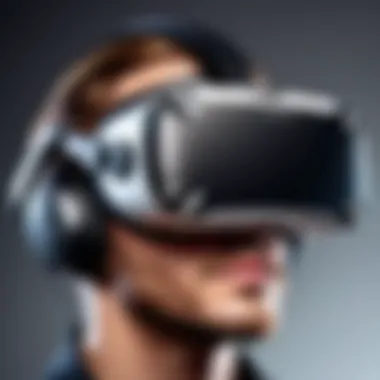
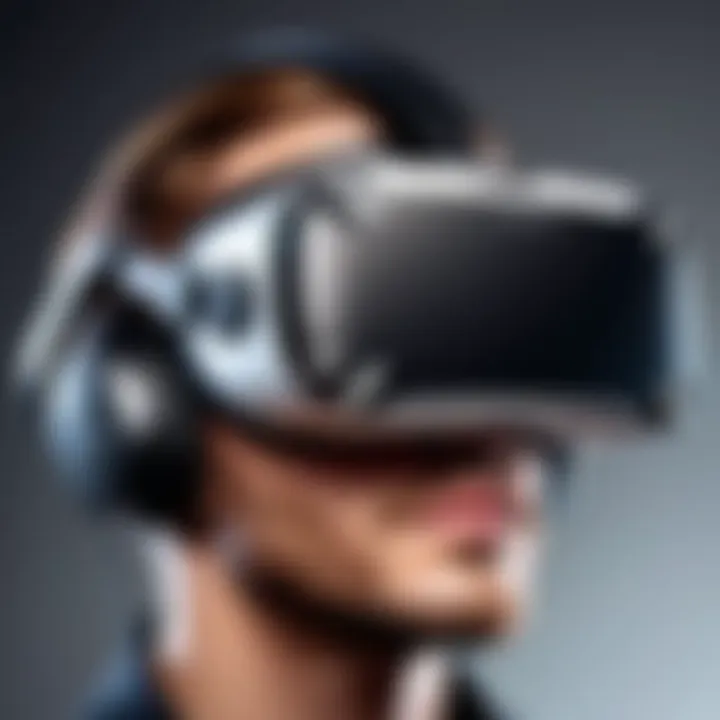
Intro
Virtual reality (VR) has become an increasingly significant part of our technological landscape. As industries from gaming to education adopt VR solutions, understanding the best products available is crucial for both IT professionals and tech enthusiasts. This guide will delve into various VR devices, showcasing their key features, specifications, and performance in real-world scenarios.
The rapid evolution of VR technology necessitates a careful analysis of what’s on the market. From the immersive Oculus Quest 2 to the powerful Valve Index, each product offers unique advantages and disadvantages. This article aims to equip readers with detailed insights, helping them make informed decisions tailored to their specific needs. The implications of VR extend beyond entertainment; they reach into areas such as training, therapy, and virtual collaboration, making this knowledge even more essential.
Product Overview
Understanding the myriad offerings in the VR space starts with a comprehensive overview of the products themselves. Here, we explore some of the top contenders, illuminating their standout features and technical specifications.
Key Features
- Oculus Quest 2
Standalone operation without the need for a PC.
High-resolution display for an impressive visual experience.
A wide library of games and applications. - Valve Index
High-fidelity visuals with exceptional refresh rates.
Precise tracking capabilities with base stations.
Comprehensive adjustments for comfort during prolonged use. - HTC Vive Pro
Dual OLED displays providing rich colors and contrast.
Integrated audio solution for immersive sound.
Focus on enterprise and professional applications.
Technical Specifications
The specifications of VR devices heavily influence their performance and usability. The following is a summary of notable specifications for a few top VR products:
- Oculus Quest 2:
Resolution: 1832 x 1920 per eye
Refresh Rate: Up to 120 Hz
Weight: 503 grams
Compatibility: Standalone - Valve Index:
Resolution: 1440 x 1600 per eye
Refresh Rate: 80/90/120 Hz
Weight: 809 grams
Compatibility: Requires a powerful PC - HTC Vive Pro:
Resolution: 2880 x 1600 total
Refresh Rate: 90 Hz
Weight: 555 grams
Compatibility: Requires a PC
Performance Analysis
In order to grasp how these VR products perform, a closer analysis is necessary. This section assesses benchmark test results and considers real-world usage scenarios.
Benchmark Test Results
Performance benchmarks provide objective data that can help potential buyers understand system capabilities. Results show that:
- The Oculus Quest 2 excels in compatibility with a broad range of applications, making it a go-to choice for casual gamers.
- The Valve Index outperforms competitors in terms of refresh rate and responsiveness, ideal for demanding VR applications.
- The HTC Vive Pro ranks highly for professional use cases, particularly in training and simulation purposes.
Real-World Usage Scenarios
The practical application of VR products varies across contexts. For instance, the Oculus Quest 2 has gained popularity for home gaming and fitness. Meanwhile, the Valve Index is often leveraged in VR arcades due to its premium performance and trackability. Lastly, the HTC Vive Pro is favoured in corporate settings for training and demonstrations.
"Choosing the right VR product involves understanding both technical details and personal use cases. Each device has its own strengths in different environments."
Prelude to Virtual Reality Technology
The significance of virtual reality technology cannot be overstated. As we enter a new era dominated by digital interactions, VR stands out as a transformative force. It reshapes how we engage with content, communicate, and perceive the world. This article aims to guide readers through the intricate landscape of VR products, emphasizing their vital role in multiple sectors ranging from entertainment to healthcare.
In this comprehensive review, we will precisely define VR, delve into its historical trajectory, and examine its current applications. By understanding the essence and evolution of VR, readers will be better equipped to appreciate the advancements in product offerings and their implications for future developments.
Defining Virtual Reality
Virtual Reality, often abbreviated as VR, refers to a simulated experience that can resemble or differ significantly from the real world. It typically employs headsets, which immerse users in digital environments. These environments can be interactive, allowing users to navigate and manipulate virtual elements. The primary objective of VR is to create realistic sensations and experiences through sensory feedback, commonly sight and sound, but increasingly incorporating other senses like touch.
Key elements of VR include:
- Immersion: Users feel present in a different environment, enhancing the experience.
- Interaction: Users can engage with the virtual world through various input devices.
- Realism: High-quality graphics and sound contribute to a convincing simulation.
Understanding these aspects is crucial for appreciating the complexities involved in VR product development. Further, it establishes a foundation for evaluating the effectiveness of various devices in delivering authentic experiences.
The Evolution of VR
The timeline of VR technology is marked by rapid advancements and conceptual shifts. Its history began in the 1960s, where early prototypes like the "Sensorama" explored multi-sensory experiences. However, it wasn't until the resurgence in the 1990s that VR entered public consciousness, largely driven by developments in gaming and entertainment sectors.
Subsequent years saw technological developments that enhanced graphic fidelity and user engagement. The introduction of more accessible consumer products, such as the Oculus Rift in 2016, marked a turning point, igniting widespread interest in VR across various disciplines.
Today, VR is applied in numerous fields, including:
- Gaming: Immersive experiences dominate the gaming industry, allowing for unprecedented interaction.
- Education: Institutions utilize VR for virtual classrooms and training simulations, providing hands-on experience without risk.
- Healthcare: Medical professionals use VR for training and patient treatment, showcasing its diverse applications.

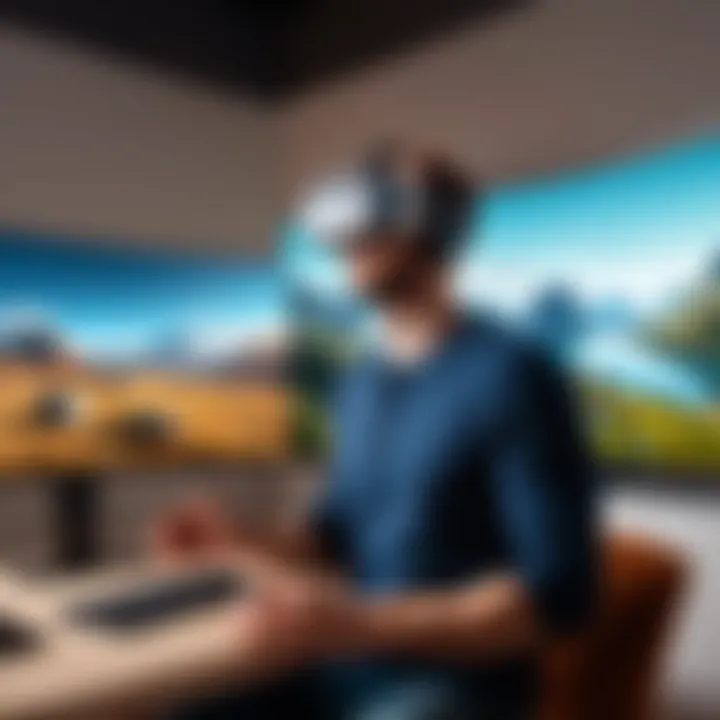
Understanding the historical context of VR establishes relevance for assessing current products and anticipating future trends. This rich history, coupled with ongoing innovation, sets the stage for an insightful exploration of VR products in this article.
"Virtual Reality is not just a tool for gaming; it's a new medium for storytelling and interaction across various fields."
By analyzing these diverse elements, this section aims to clarify the multifaceted nature of virtual reality technology, paving the way for further discussions on product selection and optimization.
Criteria for Selecting VR Products
Selecting the right virtual reality product requires careful consideration of various criteria. This process is significant for ensuring that the chosen device meets the user's specific needs, whether for gaming, training, or other applications. The complexity of VR technology makes it essential to focus on key specifications and user experience factors. These aspects can determine the overall satisfaction and usability of a VR product, allowing users to make an informed decision.
Key Specifications to Consider
Resolution
Resolution is a critical element in evaluating VR products. It directly impacts the clarity and detail of the visuals experienced by the user. Higher resolution provides sharper images, which leads to immersive experiences. A common resolution standard for VR headsets is 2160 x 1200 pixels, offering a balance of performance and clarity. However, higher resolutions can also increase the demand on the hardware. For a detailed experience, resolutions like 4K are becoming increasingly popular. Users must weigh the benefits of visual fidelity against potential hardware costs.
Field of View
Field of view (FOV) refers to the extent of the observable environment. In VR, a wider FOV enhances immersion by allowing users to see more of the virtual world. A typical FOV ranges from 90 to 110 degrees, but some advanced headsets offer broader angles. A greater FOV can help reduce the feelings of disconnect between the real and virtual worlds. However, not all users may notice the difference, and broader views might sometimes lead to performance issues.
Frame Rate
Frame rate is another foundational characteristic for VR experiences. It describes the number of frames displayed per second. A higher frame rate results in smoother motion and improved interactions within the virtual environment. A frame rate of 90 frames per second is often considered the minimum to prevent motion sickness, which can occur if the visuals are jerky or lag behind the user's movements. Thus, aiming for a high frame rate is beneficial for both comfort and realism in VR.
Tracking Method
The tracking method of a VR device determines how accurately it can monitor the user’s movements in real-time. Different technologies exist, such as inside-out tracking and outside-in tracking. Inside-out tracking uses sensors on the headset to map the room, while outside-in relies on external sensors that track the headset's position. Each method has its advantages; for instance, inside-out is generally easier to set up, while outside-in may offer higher accuracy. Potential buyers should consider how tracking impact the overall user experience in different applications.
User Experience Factors
Comfort
Comfort plays a vital role in prolonged VR usage. A headset that fits well and feels light can significantly enhance the user experience. Design elements such as adjustable straps, face padding, and weight distribution contribute to overall comfort. Users often prioritize comfort to avoid fatigue or discomfort during long sessions. However, what feels comfortable to one person might not be to another, making it essential to try on devices when possible.
Ease of Use
Ease of use includes the setup process and intuitive use of the device. A user-friendly device will allow new users to navigate through the VR environment without extensive guides or support. Features such as plug-and-play capabilities and an accessible menu design can greatly affect user satisfaction. If a device is overly complicated, it may deter users from fully engaging with the available content.
Software Compatibility
Software compatibility ensures that the VR device can run a variety of applications and games. A broader range of compatible software increases the usability and longevity of a VR headset. Some products may come with software limitations, reducing their appeal. Users should research available titles to ensure the device suits their interests, as a headset with limited compatibility might feel lacking in the long run.
"Selecting VR products is not just about specifications; it's about understanding the user's needs and experiences."
Taking into account these specifications and user experience factors will guide your decision-making process when choosing a VR product. Each consideration ties back to the ultimate goal of achieving the best possible virtual experience.
Top VR Headsets Available
In the realm of virtual reality, the headset is the centerpiece of the experience. It dictates how users perceive and interact with digital environments. Selecting the right VR headset can significantly impact the quality and immersion of the experience. This section explores various headsets categorized by their pricing spectrum, considering aspects like performance, features, and user needs.
High-End VR Headsets
Oculus Quest
Oculus Quest stands out for its versatility. This headset functions as both a standalone device and a PC-connected option. Its key characteristic is the all-in-one design, which eliminates the need for external sensors or a powerful gaming PC. Users appreciate the freedom to move without being tethered. A unique feature of Oculus Quest is its inside-out tracking technology, which allows it to track users’ movements in real time without additional hardware. While it offers substantial flexibility, some may note the graphical fidelity isn't as high as more tethered models.
HTC Vive Pro
HTC Vive Pro is known for its superior performance, especially in terms of visuals and audio. The headset boasts a high resolution and wide field of view. This makes it a premium choice for enthusiasts and professionals alike. A notable aspect is the enhanced audio system, which delivers immersive sound experiences. However, it requires a powerful PC, which may not be practical for all users. Furthermore, it's priced at the higher end of the spectrum, making it less accessible than others.
Valve Index
Valve Index is renowned for its motion tracking precision and visual clarity. It utilizes external base stations for tracking, which can result in an optimal gaming experience. Its key characteristic is the high refresh rate that significantly reduces motion blur. This feature makes it particularly advantageous for fast-paced games. However, the need for setup with base stations can be a barrier for some users. Additionally, the cost can be considerable.


Mid-Range VR Options
Oculus Rift S
The Oculus Rift S continues the legacy of the Oculus brand with a focus on quality and accessibility. It is designed for those looking for good performance without the high costs of premium headsets. A crucial feature is the 5 USB port setup, which enhances usability and ease of integration with various PC setups. The Rift S has an improved display over its predecessor, but it also requires a wired connection to a gaming PC, which some users may find limiting.
PlayStation VR
PlayStation VR has carved a niche among console gamers. Designed to integrate seamlessly with the PlayStation 4 and upcoming PS5, it makes VR accessible to a wide audience. Its key characteristic is the strong library of exclusive games. A unique feature is the PlayStation Camera, which aids in providing motion tracking. The graphics quality, however, may not match that of high-end PC systems.
HP Reverb G2
HP Reverb G2 is notable for its impressive resolution, making it ideal for detailed experiences in simulations and design. This VR option caters to users who prioritize clarity. Its standout feature is the high-resolution display, offering sharp visuals. However, the tracking capabilities are sometimes viewed as less robust compared to competitors. For simulation and creative professionals, this headsets provides strong potential, yet requires care regarding the tracking limitations.
Budget-Friendly VR Devices
Oculus Go
Oculus Go is an entry-level headset that caters to casual users. It is especially appealing for those who want an affordable introduction to VR. The key characteristic of the Oculus Go is its standalone capability, offering an easy setup. While it works well for general media consumption and light gaming, it may not support intensive apps or games, limiting its appeal for serious gamers.
Samsung Gear VR
Samsung Gear VR employs smartphones to provide virtual reality experiences, combining accessibility with functionality. The primary advantage lies in its affordability and compatibility with various Samsung devices. By leveraging existing technology, it allows users to step into VR without significant investment. However, the quality and performance depend heavily on the smartphone being used. This means experiences can vary greatly.
Google Cardboard
Google Cardboard is the most budget-friendly solution available, designed to make VR accessible to everyone. It is essentially a cardboard viewer that utilizes a smartphone for display. The unique characteristic is its extreme portability and simplicity. However, this device is limited in graphics and functionality, making it suitable primarily for casual exploration of VR rather than intensive use. While it serves as an introduction to VR, its capabilities are considerably basic.
"Selecting the right VR headset is crucial for enhancing the overall user experience and can significantly influence your engagement with virtual spaces."
In summary, when choosing from these headsets, consider factors like budget, intended use, and desired features. The right headset will significantly enhance one’s engagement with virtual environments and provide a fulfilling experience.
VR Accessories and Enhancements
VR technology finds its full potential when paired with appropriate accessories. These enhancements not only augment the user experience but also expand the range of applications for virtual reality. Investing in accessories can lead to a more immersive environment, allowing users to explore virtual worlds in a way that is both engaging and natural. The scope of this section focuses on three main categories: motion controllers, haptic feedback devices, and audio solutions.
Motion Controllers
Motion controllers are essential for interactivity in virtual environments. They allow users to manipulate objects, navigate menus, and perform specific actions through physical gestures. The advantages of motion controllers include:
- Precision and Accuracy: Most modern controllers integrate motion tracking technology, ensuring movements in the virtual space align closely with actual physical movements.
- Intuitive Experience: Users do not need to rely on traditional gamepads. Instead, they use hand motions that feel more natural, which helps in reducing the learning curve.
- Expanded Functionality: Many motion controllers come with additional features like force feedback and triggers, increasing the depth of interaction in games and applications.
The Oculus Touch and the Valve Index controllers are noted for their performance and ergonomic design, making them highly recommended for a wide range of VR experiences.
Haptic Feedback Devices
Haptic feedback devices enhance immersion by providing tactile sensations in response to actions in the virtual world. The importance of haptic technology in VR is pronounced across various sectors. Some benefits include:
- Enhanced Engagement: Haptic feedback makes simulations feel more lifelike. Users sense physical forces, impacts, or movements, which adds a layer of realism.
- Training Applications: In fields like healthcare and aviation, realistic haptic feedback can play a crucial role as it better prepares users for real-life scenarios.
- Variety of Devices: Options range from handheld products, like haptic gloves, to full-body suits that synchronize with VR experiences.
Popular examples include HaptX Gloves and bHaptics TactSuit. Both have proved valuable in areas requiring heightened realism and precision.
Audio Solutions for VR
Audio is often an underappreciated aspect of VR, but it plays a crucial role in creating an authentic experience. The right audio solutions can:
- Enhance Spatial Awareness: 3D spatial audio allows users to understand their surroundings better. This means sounds can be placed based on their virtual location, which is particularly important in gaming and training environments.
- Immersion Factor: Quality speakers or headphones paired with VR can transport users deeper into simulations. The sounds of the environment significantly shape user perception and interaction within the virtual world.
- Compatibility: Integrated audio solutions vary across VR headsets. Some models like the Valve Index have built-in speakers, while others might require external headphones to achieve the best sound fidelity.
Applications of VR in Various Fields
Virtual reality (VR) has transcended the realm of gaming and entertainment, establishing itself in a multitude of sectors. The importance of understanding the applications of VR lies in its capacity to alter how professionals and consumers alike interact with technology. This section explores several influential domains, examining how VR enhances user experience, brings about cost efficiencies, and improves educational outcomes, among other factors.
Gaming and Entertainment
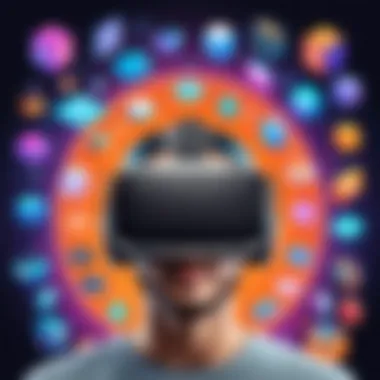
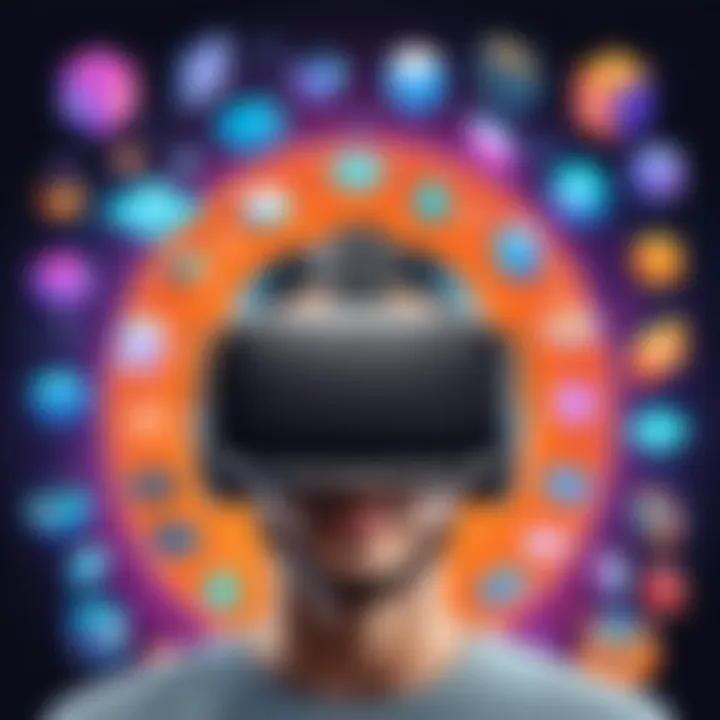
The gaming industry is arguably the most recognized domain for virtual reality applications. VR transforms traditional gameplay into immersive experiences, enabling users to engage in virtual worlds that feel real. The technology allows for a more emotional connection. When a player wields a sword or navigates a fantastical landscape, they experience heightened sensations of presence.
Popular platforms like Oculus Quest and Valve Index have elevated these experiences. The advanced graphical capabilities and responsive controls make video games more engaging than before. One crucial element is the social interaction VR fosters. Players from different locations can collaborate or compete in real-time, expanding the potential for multiplayer gaming.
Training and Simulation
In professional settings, VR serves a crucial role in training and simulation, where real-life risks are too high. Industries such as aviation, military, and manufacturing utilize VR environments to train personnel. These simulations replicate real-world scenarios, allowing learners to practice skills without tangible consequences.
For example, a pilot can practice takeoff and landing procedures in a risk-free VR simulation. This approach not only enhances skills but also increases retention of knowledge. Companies benefit from reduced training costs and increased safety.
"Utilizing VR in training can revolutionize skill acquisition, reducing time and expense while increasing retention and effectiveness."
- Anonymous Expert
Healthcare Applications
Healthcare is another sector where virtual reality demonstrates profound potential. VR can provide medical professionals with simulations for surgical procedures, allowing for practice and refinement without actual patients. This is especially beneficial for complex operations, enhancing a surgeon’s dexterity before they operate.
Additionally, VR is used for pain management. Patients undergoing procedures may find relief through distracting, immersive experiences. Beyond immediate comfort, VR can also contribute to mental health treatment. Therapists can use VR to expose patients to anxiety-inducing situations in controlled environments, facilitating gradual exposure therapy.
Conclusively, VR is not merely a tool of leisure. It holds significance across various fields. Whether it's enhancing gaming experiences or training professionals in high-stakes environments, virtual reality technology is reshaping our approach to multiple industries. Understanding these applications benefits not just the tech world, but society as a whole.
Future Trends in VR Technology
The landscape of Virtual Reality (VR) continues to expand and evolve at a rapid pace. Understanding the future trends in VR technology is essential for anyone involved in IT and tech. These trends not only reflect advancements but also forecast the direction the industry is heading. Insight into these trends can influence purchasing decisions, implementation strategies, and development initiatives. Below, we explore the distinct components that are shaping the future of VR.
Advancements in VR Hardware
Hardware enhancements are setting the stage for more immersive and comfortable VR experiences. Key advancements include improved display technology, lightweight materials, and better battery life. High-resolution displays minimize the screen-door effect, delivering clearer images. Moreover, advancements in optics help in achieving a more realistic field of view which is critical for a convincing virtual experience.
Another significant hardware trend is the integration of standalone VR headsets. Products like the Oculus Quest are demonstrating that wireless functionality does not detract from performance. Such devices are increasingly accessible, promoting wider adoption of VR.
"The trend towards wireless and autonomous VR systems signifies a significant move towards user-friendly experiences that eliminate any physical limitations, allowing the full range of immersion."
Software Developments and Innovations
Software innovation is pivotal to enhancing VR experiences. New engines such as Unreal and Unity continuously evolve, enabling developers to create more sophisticated VR environments. Enhanced tools for creating interactive content make VR development easier and more efficient.
Innovative software also focuses on user experience improvements. More responsive interfaces and adaptive learning protocols bring personalized experiences for users. Cloud computing is another avenue for software evolution, allowing for more complex computations to take place off-device. This shift could mean lighter hardware without sacrificing depth or quality of the VR experience.
Impact of AI on VR Experiences
The integration of Artificial Intelligence (AI) into VR is transforming how users interact with virtual environments. AI can enhance user experiences by learning user preferences and adapting content in real-time. This capability leads to personalized experiences that feel more intuitive and engaging.
AI algorithms can also be utilized to create more dynamic and responsive NPC (non-player character) interactions in gaming. Such developments make virtual worlds feel alive, adding a new dimension to user engagement. Additionally, AI-powered analytics can help developers understand user behavior better, leading to more tailored content in the future.
In summary, the trends in VR technology demonstrate a clear trajectory towards enhanced user experiences, better hardware, and innovative software solutions. Keeping abreast of these developments is crucial for professionals and enthusiasts alike, as they point towards not just the immediate future but also long-term implications in VR.
Culmination
The conclusion section of this article summarizes the insights gathered throughout the exploration of virtual reality products. It synthesizes key findings regarding hardware, applications, and trends, making it clear that VR technology is rapidly evolving and offers significant potential across various sectors. Understanding these developments is essential for IT professionals and tech enthusiasts seeking to keep pace with innovations and make well-informed decisions.
Summary of Findings
In examining the landscape of virtual reality, several points emerge as crucial:
- Diverse Product Range: The marketplace features a wide variety of VR products, catering to different budgets and intentions. From high-end headsets like the Oculus Quest to budget-friendly devices such as Google Cardboard, there are options for every user.
- Technological Innovation: Advancements in resolution, frame rates, and tracking methods enhance the overall VR experience. This is particularly relevant in gaming and entertainment, where immersive environments are crucial.
- Applications Beyond Gaming: VR’s role extends into fields such as healthcare and training, showcasing its versatility. These applications not only improve training outcomes but also offer new ways for engaging with patients.
The significance of these findings lies in their ability to guide users in evaluating which VR devices and applications best meet their specific needs, based on performance metrics and practical application.
Final Thoughts on VR Products
As virtual reality continues to mature, the consideration of a product should extend beyond just technical specifications. Factors such as comfort, ease of use, and software compatibility play vital roles in the overall user experience.
Investing in VR technology presents not only an opportunity to engage with cutting-edge hardware but also to participate in an increasingly interconnected environment.
"The future is now, and VR is leading the way to unexplored possibilities in interaction, training, and beyond."
Engagement with virtual reality technology can transform both professional and personal experiences. As this domain continues to develop, those who invest time in understanding it will be best positioned to leverage its full potential.



